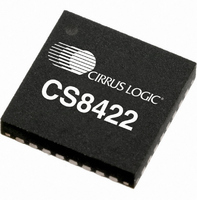CS8422-CNZ Cirrus Logic Inc, CS8422-CNZ Datasheet - Page 35

CS8422-CNZ
Manufacturer Part Number
CS8422-CNZ
Description
IC SAMPLE RATE CONVERTER 32QFN
Manufacturer
Cirrus Logic Inc
Type
Sample Rate Converterr
Datasheet
1.CS8422-CNZ.pdf
(82 pages)
Specifications of CS8422-CNZ
Package / Case
32-QFN
Applications
Digital Audio
Mounting Type
Surface Mount
Maximum Operating Temperature
+ 125 C
Minimum Operating Temperature
- 55 C
Mounting Style
SMD/SMT
Package
32QFN
Operating Temperature
-55 to 125 °C
Audio Control Type
Sample Rate Converter
Control Interface
I2C, SPI
Supply Voltage Range
1.71V To 5.25V
Operating Temperature Range
-40°C To +85°C
Audio Ic Case Style
QFN
No. Of Pins
32
Rohs Compliant
Yes
Lead Free Status / RoHS Status
Lead free / RoHS Compliant
For Use With
598-1568 - BOARD EVAL FOR CS8422 RCVR
Lead Free Status / Rohs Status
Lead free / RoHS Compliant
Other names
598-1732
Available stocks
Company
Part Number
Manufacturer
Quantity
Price
Company:
Part Number:
CS8422-CNZ
Manufacturer:
CIRRUS
Quantity:
99
Part Number:
CS8422-CNZ
Manufacturer:
CIRRUS
Quantity:
20 000
Part Number:
CS8422-CNZR
Manufacturer:
CIRRUS
Quantity:
20 000
DS692F1
The first option allows access directly through registers. The first 5 bytes of the Channel Status block are
decoded into the
data. Registers 28h-2Ch contain the B channel status data.
Received Channel Status (C), User (U), and EMPH bits may also be serial outputs to the GPO pins by
appropriately setting the GPOxSEL bits in the
made available to qualify the C and U data output. In serial port slave mode, VLRCK and RCBL can be
made available to qualify the C and U data output. VLRCK is a virtual word clock, equal to the receiver
recovered sample rate, that can be used to frame the C/U output. VLRCK and RCBL are available through
the GPO pins.
C-data or U-data with either OLRCK1 or OLRCK2, the corresponding serial port must be directly sourced
by the AES3 receiver (not the SRC).
To source an SDOUT signal directly from the RX receiver, the receiver should be set in master mode in
order to recover the received data. In this configuration, the SDOUT signal sourced from the receiver will
toggle at the AES frame rate. If the RX receiver is set to slave mode, the user must ensure that its asso-
ciated input OLRCK signal is externally synchronized to the input S/PDIF stream in order to recover the
received data. In both configurations, VLRCK is equal to the OLRCK signal associated with the serial port
used to clock the recovered receiver data.
When both SDOUTs are sourced from the RX receiver, VLRCK will equal OLRCK1. When both SDOUTs
are sourced from the SRC, then VLRCK will equal the recovered AES frame rate, not OLRCK.
The user may also access all of the C and U bits directly from the output data stream (SDOUT) by setting
bits SOFSELx[1:0]=11 (AES3 Direct mode) in
rial Audio Output Data Format - SDOUT2
signal by external control logic such as a DSP or microcontroller. AES3 Direct mode is only valid if the
serial port in question is directly sourced by the AES3 receiver (not the SRC).
If the incoming User data bits have been encoded as Q-channel subcode, the data is decoded, buffered,
and presented in 10 consecutive register locations located in
An interrupt may be enabled to indicate the decoding of a new Q-channel block, which may be read
through the
The encoded Channel Status bits which indicate sample word length are decoded according to
AES3-2003 or IEC 60958. The number of auxiliary bits are reported in bits 7 through 4 of the
Channel Status
“Interrupt Status (14h)”
Figure 19
(11h)”.
SDOUT1
“Channel Status Registers (23h -
SRC
SRC
RX
RX
illustrates timing of the C and U data, and their related signals. To recover serial
SDOUT2
SRC
SRC
register.
RX
RX
Table 1. VLRCK Behavior
(0Dh)”. The appropriate bits can be stripped from the SDOUT
“GPO Control 1 (05h)”
“Serial Audio Output Data Format - SDOUT1 (0Ch)”
AES FRAMES
2Ch)”. Registers 23h-27h contain the A channel status
OLRCK1
OLRCK1
OLRCK2
VLRCK
“Q-Channel Subcode (19h - 22h)”
registers. OLRCK and RCBL can be
see
see
see
see
COMMENT
(Note 4)
(Note 4)
(Note 4)
(Note 6)
CS8422
“Receiver
register.
or
“Se-
35

















